The Missing Link Between Social Media And Your Email List
Learn how to use your email list to develop your brand's social media presence. We cover the best practice tips to convert your mailing list into engaged social media followers, and vice versa. Plus how to use social media to recruit new subscribers to your list with seamless integration.
Email is often heralded as the holy grail of digital marketing itself.
And hey, we totally understand why.
According to SmartCompany’s 2018 Australian Email Marketing Report, the average Aussie business saw a $22.78 ROI for every $1 spent on email last year.
Crazy, right?
Having around-the-clock access to your customers via email is invaluable. Over time, you can build rapport with your list to the point where they’re more than happy to see your offers time and time again.
Of course, social media has proven to be an effective channel for doing the same. The end-game for many businesses, though, is to get into their customers’ inboxes.
And so you might be asking yourself: which channel should I prioritize to score that sweet, sweet ROI.
Is it email? Is it social?
The real question we should be asking is this: why not both?
UPDATE: Before we get stuck into bringing together your email and social media marketing, here are a few statistics from Campaign Monitor about engagement with email in Australia. You can use these stats as a benchmark for your campaigns.
Average email benchmarks for all industries in Australia:
- Average open rate: 19%
- Average click-through rate: 2.7%
- Average unsubscribe rate: 0.2%
- Average bounce rate: 0.9%
Best and worst days for email marketing:
- The best day for highest email open rates: Tuesday 19.7%
- The worst day for lowest email open rates: Saturday 17.9%
How to Grow Your Social Followers and Email Subscribers at the Same Time

Here’s the deal: building your email and social followings shouldn’t be treated as a matter of either/or. Both mediums actually compliment each other brilliantly.
By double-dipping your email and social campaigns, you can build both lists simultaneously while also building up trust with your audience. The result is more consistent, compelling marketing with less time wasted putting it all together.
In this guide, we’ll break down how you can align your email marketing and social media presence. From small tweaks to full-blown ad campaigns, consider how you can maximize your time while growing your respective lists.
1. Showcase Your Social Presence in Your Emails
Let’s start with the easy stuff!
Showcasing social media content in your emails is a no-brainer. Effective email marketing requires compelling visuals and your social feed is the perfect place to pull imagery from.
Think about it. There’s a non-zero chance that any given picture on your brand’s Instagram feed is more interesting than a stock photo, right?
Social content is prime email content, plain and simple. Take a look at Vegemite’s welcome email as a prime example.
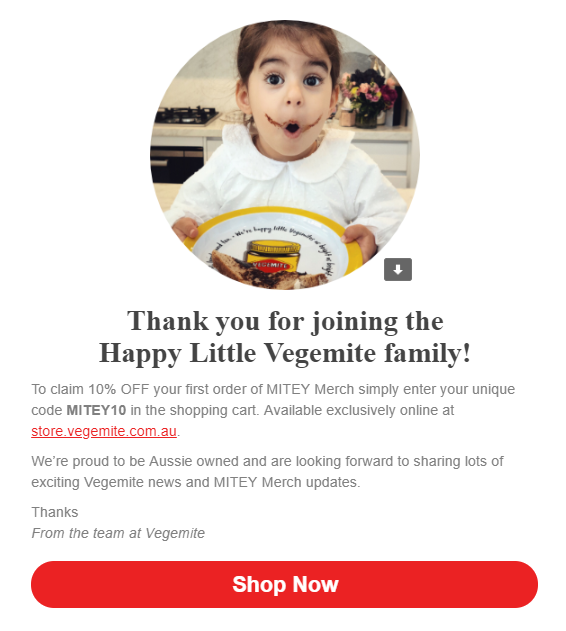
Where have I seen that before?
Beyond simply featuring content in your emails, there are some specific, low-hanging tactics that can help you grow your social traffic. These tactics are fair game for newsletters, offers and everything in-between.
Social Icons
Granted you’re linking out to your social channels, each and every email you send is an opportunity for new followers.
Social buttons are a stylish, strategic way to funnel your subscribers to your social pages. Although some businesses use text links, social icons provide some much-needed creative flair to your emails. Below is a prime example from Luna Park Sydney which looks sleek and totally on-brand.
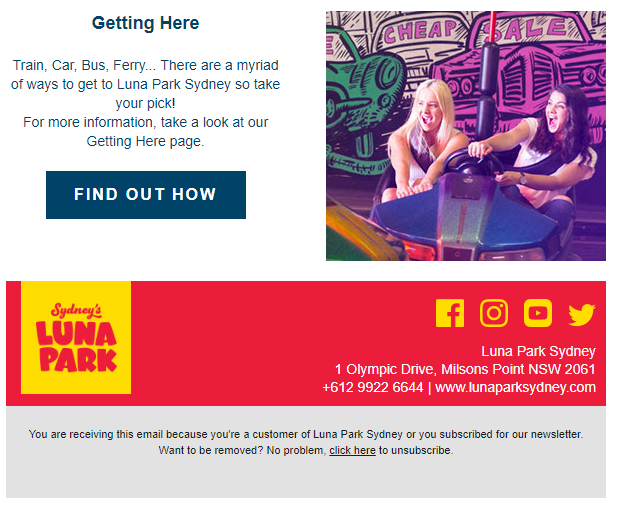
Social icons don’t necessarily need to pop out at you: they simply serve as an opportunity for subscribers to click or tap to your social page without leaving their email app. Here’s a subtle but effective example from The Iconic.

In addition to brand emails, social icons are great for your personal or employee accounts, too.

Here’s a good resource for social buttons if you’re starting from scratch or don’t have a dedicated designer. Meanwhile, Hubspot’s email signature generator is a useful tool if you want a social signature for a personal Gmail or Outlook account.
Promote Your Hashtag
Believe it or not, email can be part of your social hashtag strategy.
Because the more places you put your hashtag on display for customers to see, the better. Email is no exception.
Here’s an awesome example from Bellroy, pointing out their #mybellroy tag as part of their footer which also invites subscribers to follow their social accounts.

User-Generated Content
User-generated content such as customer photos represents some of your brand’s most powerful imagery. Serving as proof of your satisfied customers, showing off UGC via email makes perfect sense for brands trying to promote their hashtag, too.
Black Milk does an awesome job of promoting multiple social channels through UGC-based emails.
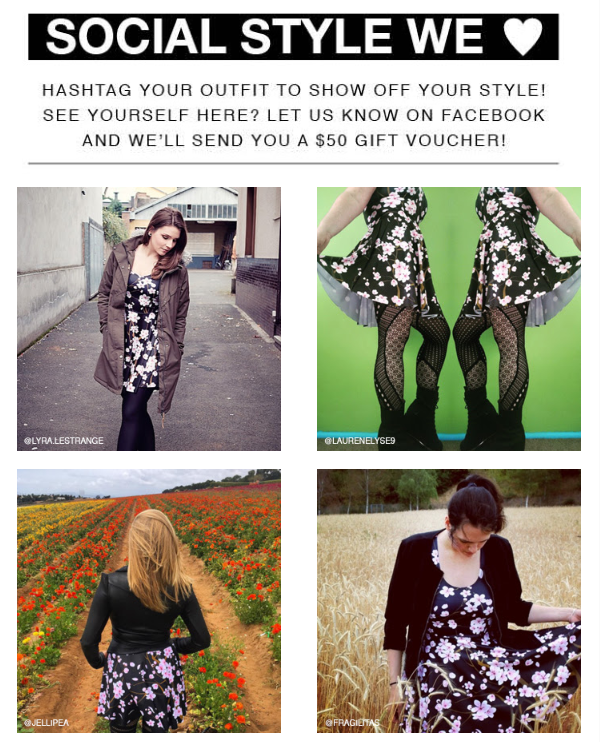
By tagging customer photos on Instagram, fans are automatically in the running for a $50 voucher. The catch? Winners are exclusively announced through email and the vouchers can only be redeemed on Facebook. This leads to customers bouncing between social and email to see if they’ve won.
That’s some serious marketing synergy, isn’t it? It’s also evidence that email and social media are much closer linked than some marketers might think.
2. Collect More Email Addresses with Social Landing Pages
Don’t let anyone tell you that social traffic is “junk” traffic.
Through well-crafted social landing pages, brands can drive targeted traffic to specific promotions and collect a ton of email addresses in the process.
Case in point, “About” links on Facebook or bio links on Twitter and Instagram are all valuable real-estate for acquiring opt-ins. Check out how Kiehl’s Australia’s trackable Instagram link leads directly to a promotion offering free samples and tips in exchange for an email address.
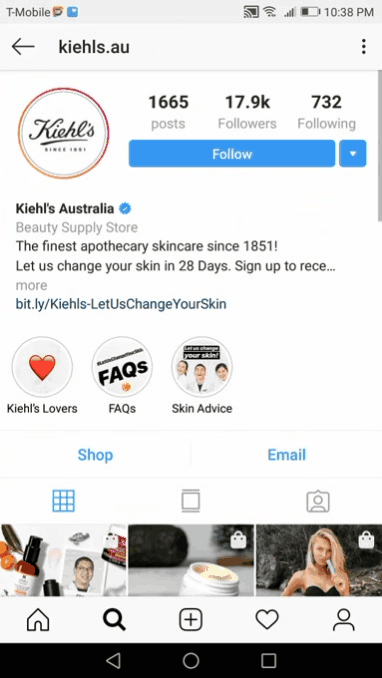
Let’s look at another effective example. As you can see, PopCherry’s bio link leads to their shoppable Instagram, right?
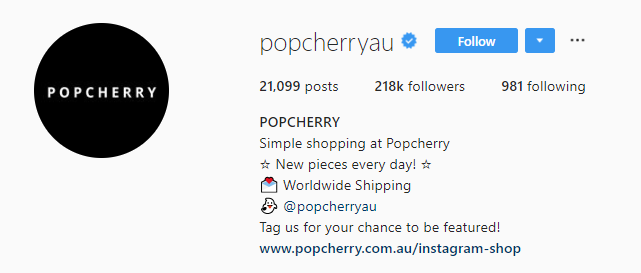
After spending some time browsing the store, visitors are then hit with this discount pop-up. This is yet another way to transform social traffic into opt-ins.
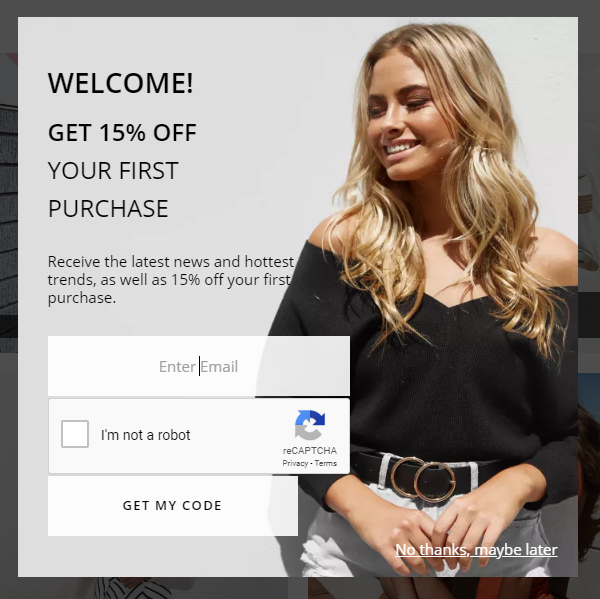
GoPro Australia likewise rolls out a similar sort of pop-up on their landing page from Instagram.
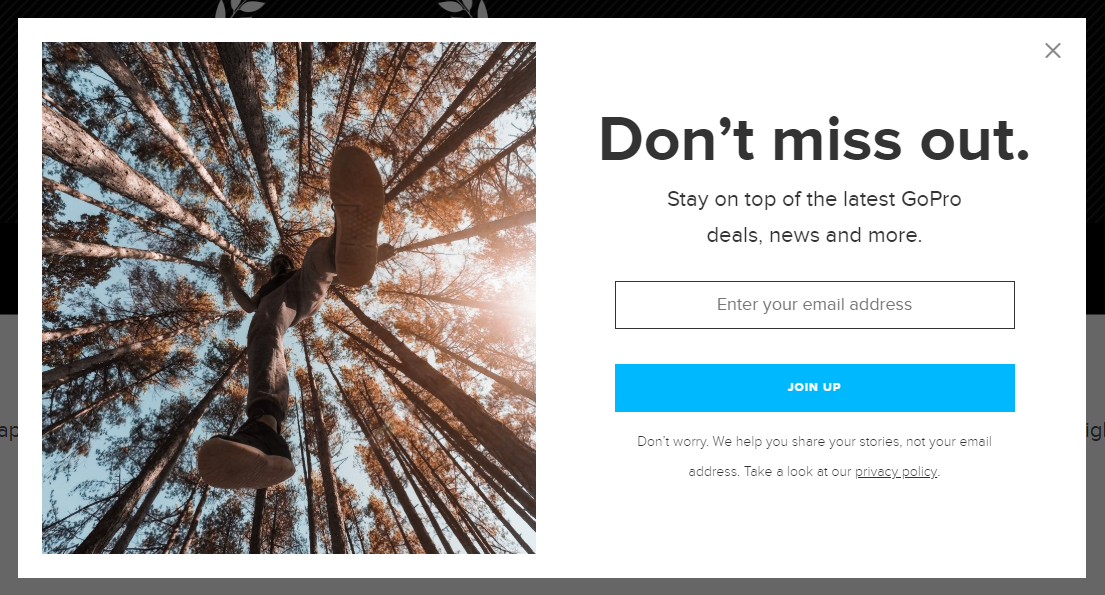
See how that works?
3. Gather Emails Through Social Media Contest Entries
Piggybacking on the last tip, social media competitions represent specific content campaigns centred around collecting email addresses.
Brands still point to their bio link as per usual. The difference is that there are typically multiple posts hyping up the competition and therefore driving more attention to their landing page.
Think about it: how often do you really think your followers are checking out your bio unless specifically prompted to do so? Here’s an example of a hype post from Lipstik Shoes.
Unlike smaller tag-a-friend contests, bigger giveaways require detailed entrant information which almost always includes an email address. A big prize (in this case, $2,500 worth of beauty products) is definitely more enticing than a small discount.

4. Use Your Email List to Beef Up Your Social Ad Campaigns
With Facebook’s organic reach plummeting for many brands within the past year, running paid ads has become a must-do.
Brands with an active email list arguably have the most to gain from Facebook thanks to remarketing ads and custom audiences.
By uploading your email list to Facebook, brands can remarket to former site visitors for a sort of “second chance” to convert them. Through creating a custom audience based on your list, you also can find new customers to reach out to which resemble the most valuable ones you already have.

5. Ask for Followers and Subscribers Directly
Sometimes if you want something, it’s best to just ask for it.
This rings true for email and social media, too.
It never hurts to occasionally remind site visitors, subscribers and followers alike that your other marketing channels exist. Doing so isn’t spammy or annoying, especially if that particular channel provides something that the others don’t.
For example, Bellroy asks explicitly in their welcome email for new subscribers to become Instagram followers. Given the high-quality content they publish there, Instagram is obviously a high priority for the brand and they want as many eyeballs on that content as possible.
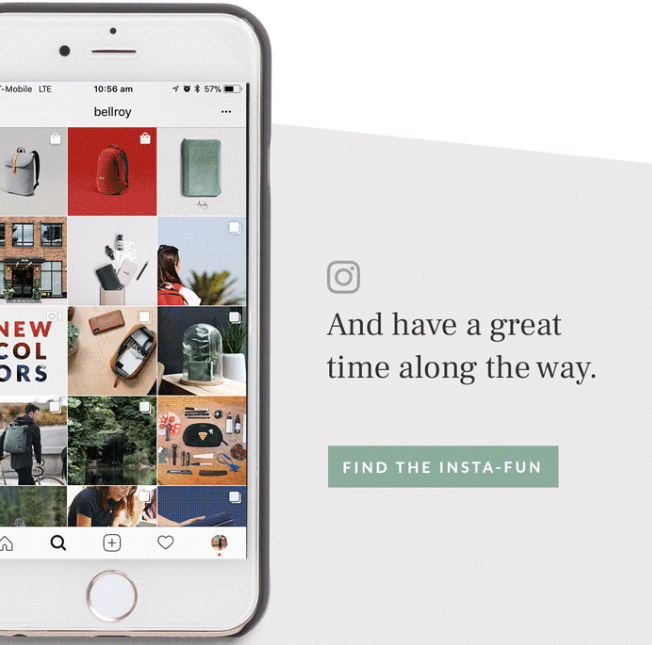
Meanwhile, the same sort of logic can be applied to brands on social who want to grow their email following.
The goal here is to create more opportunities for positive touch points between you and your customers. With a hybrid marketing strategy that’s focused on email and social together, you can do exactly that.
Are Your Social Media and Email Efforts Aligned?
No matter what you might consider your top priority marketing-wise, both email and social media deserve your undivided attention. No doubt about it.
Aligning your marketing channels does double-duty of making your campaigns more cohesive while also saving you time and energy.
And so instead of treating email and social media as islands, start thinking about how you can make them work in tandem.







